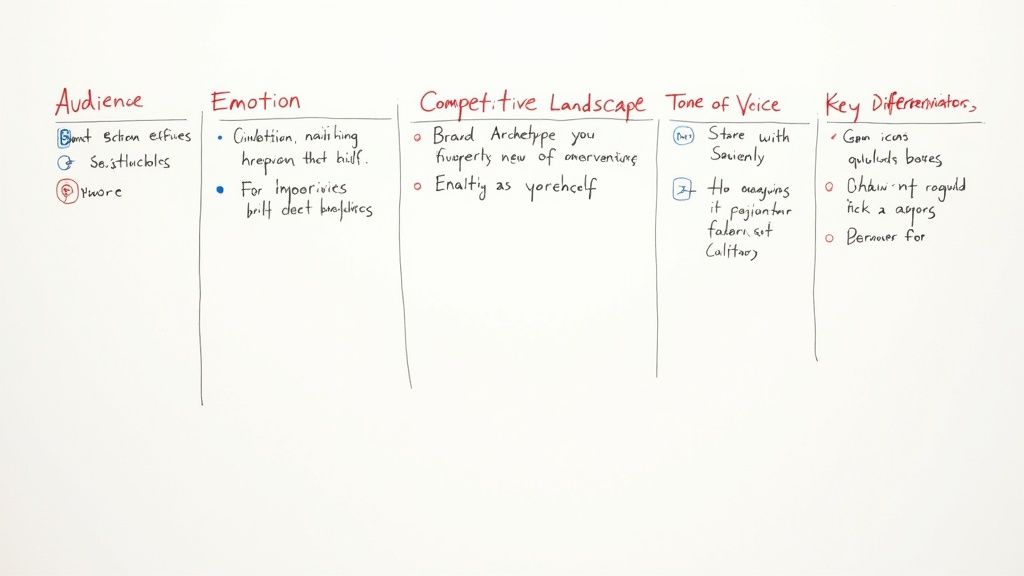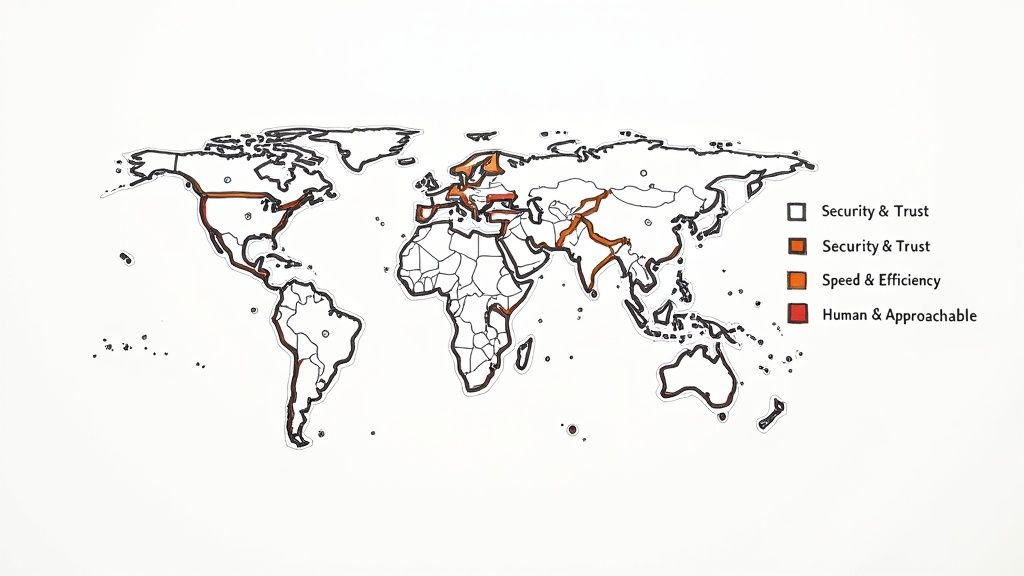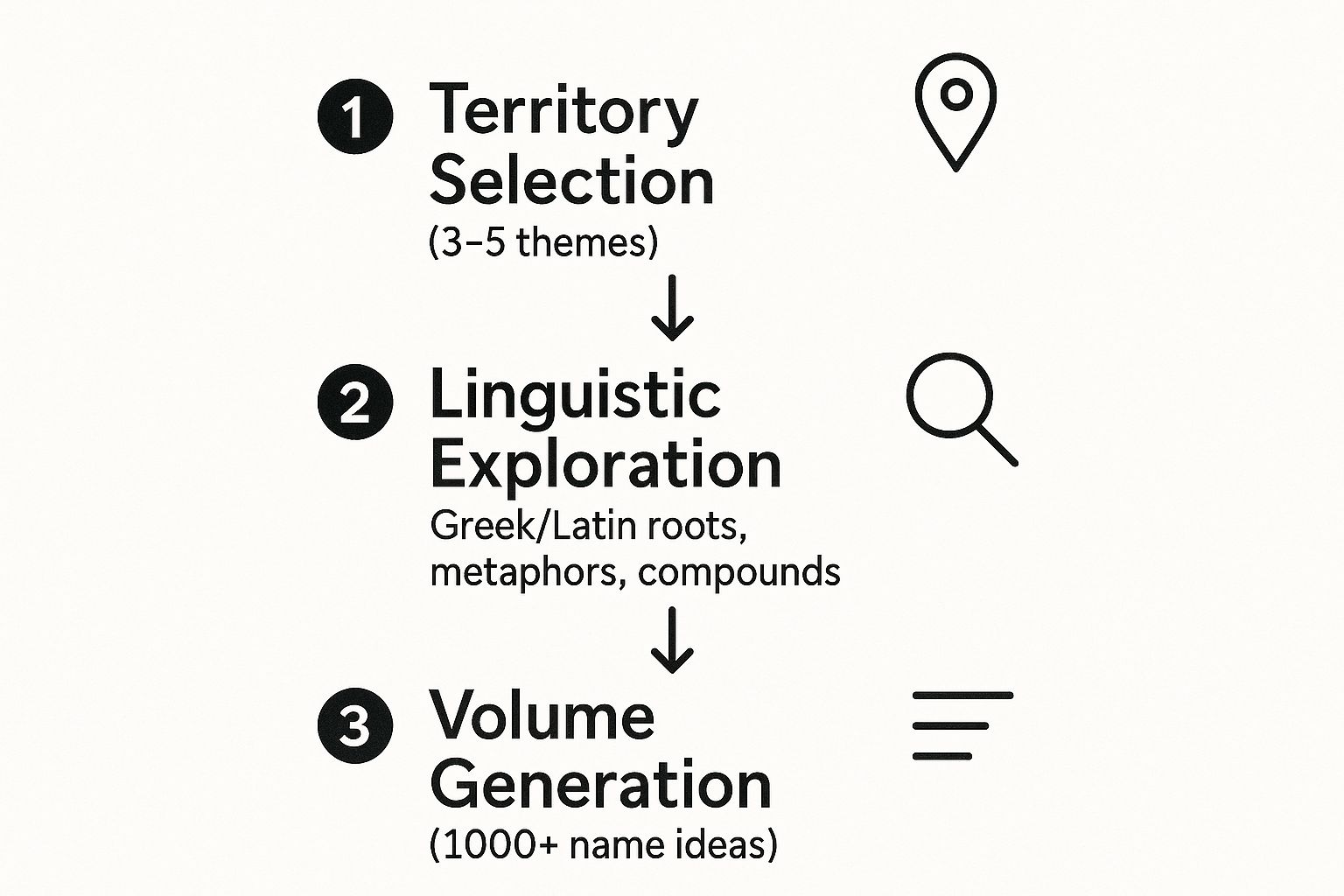How a Naming Agency Actually Works
Discover the rigorous, multi-stage agency naming process. Learn how professional agencies turn strategy into legally defensible, memorable brand names.
Most people think a brilliant brand name happens by accident a bolt of creative lightning.
Wrong. Dead wrong.
Professional agency naming isn't a random creative flash; it's a structured, rigorous system. Think of it less like abstract art and more like brand architecture. It's a repeatable process designed to build a defensible asset and sidestep catastrophic risks before they happen.
This guide pulls back the curtain on how top naming agencies really work. I'm going to walk you through the exact workflow they use to turn a strategic goal into a memorable, protectable brand name. Understanding this system is crucial, whether you're hiring an agency, a freelancer, or using a sophisticated AI tool built on these same principles.
Key Takeaways
Strategy Before Creativity: Naming isn't about brainstorming. It starts with a strategic brief that defines your audience, tone, and competitive landscape.
It's a Process of Elimination: Agencies generate thousands of ideas to find a handful of viable ones. The real work is in curation and screening, not just invention.
Screening is Non-Negotiable: Every shortlisted name must survive a gauntlet of checks: trademark databases, domain availability, and linguistic screening for negative connotations.
You're Buying De-Risking: The true value of an agency isn't just a clever word. It's clarity, process, and protection from costly legal and branding mistakes.
Step 1: The Brief — Defining the Direction
Every great name starts with clarity, not creativity. The first step is always the naming brief—a strategic blueprint that sets the rules of the game. A professional agency will always start here, guiding you through tough questions before anyone suggests a single name.
Without this, the best creativity goes nowhere. You’re just making lists of words.
The brief forces brutal honesty on the questions that matter:
Who exactly is your audience, and what language connects with them?
What is the one core emotion the name must trigger—Trust? Innovation? Disruption?
What are your competitors doing, and which naming conventions should you follow or deliberately break?

A great brief is a document of constraints. It tells the creative team where not to go, which is just as important as pointing them in the right direction. It prevents wasted cycles on ideas that are strategically dead on arrival.
Step 2: Research & Strategy — Finding the Core Idea
Once the brief is locked, the agency maps your brand's world. This isn't brainstorming; it's a strategic deep dive to identify distinct conceptual spaces where your brand’s name can credibly live.
This process involves analyzing competitor names, industry naming conventions (like tech's obsession with adding "-ify" or "-ly"), and brand archetypes. The result is a map of strategic "naming territories."
For example, a new fintech startup's territories might be:
Territory 1: Security & Trust: Inspires names that feel solid, dependable, and protective (e.g., concepts around fortress, guardian, shield).
Territory 2: Speed & Efficiency: Focuses on frictionless, fast-moving ideas (e.g., concepts around velocity, flow, synapse).
Territory 3: Human & Approachable: Explores friendly, community-focused language (e.g., concepts around kindred, relay, hearth).
This step ensures that every name generated is rooted in a core strategic idea, preventing generic or off-brand suggestions.

Step 3: Naming Fields & Word Exploration
This is where disciplined creativity begins. Guided by the strategic territories, the team’s goal is to generate massive volume and diversity. For each territory, they explore hundreds of linguistic directions.
This is more than finding synonyms. It involves digging into:
Metaphors and analogies
Greek and Latin roots
Foreign words and concepts
Invented and compound words
Phonetic experiments (playing with sound and mouthfeel)
The point isn't to find the perfect name right away. It's to build a giant sandbox of raw material. To find a few great names, you have to start with thousands of possibilities.

Step 4: Curation & Shortlisting
Out of thousands of raw ideas, only a tiny fraction survive. This curation phase is where taste and strategy meet. Each potential name is judged against a strict set of criteria:
Strategic Fit: Does it align with the brief?
Clarity: Is it easy to understand and spell?
Originality: Does it stand out from competitors?
Emotion: Does it evoke the right feeling?
Pronunciation: Is it easy to say and recall?
This is the hidden work of naming. An agency's real value is often in its ability to edit, not just invent. They kill hundreds of good ideas to find the few that are truly great—and viable.
Step 5: Linguistic & Legal Screening
This is the most critical and most frequently overlooked step. Every single shortlisted name gets shoved through a gauntlet of checks designed to identify risks early. This is what separates a professional process from amateur guesswork.
A name isn't viable until it passes these tests:
Screening Type | What It Checks | Why It's Critical |
|---|---|---|
Trademark Pre-Screen | Searches key trademark databases (USPTO, WIPO) for direct or confusingly similar marks. | Prevents investing in a name you can't legally own, avoiding costly rebranding or lawsuits. |
Domain & Social Check | Availability of the exact-match dot-com domain and key social media handles. | Ensures a cohesive digital presence, which is non-negotiable for modern brand building. |
Linguistic Screen | How the name translates and sounds in key global languages to avoid negative, embarrassing, or unintended meanings. | Protects your brand's reputation as it scales, helping you avoid cultural missteps. |
A preliminary trademark check is not legal advice, but it's an essential risk-reduction step. It filters out obvious conflicts before you invest emotionally or financially in a name you'll never be able to own.
Only the names that survive this entire gauntlet—often just 1% of the initial pool—make it to you.
Step 6: Presentation & Storytelling
The final step isn't just sending a list of words. It's a performance. An agency presents a shortlist of just three to five top contenders, each wrapped in a compelling narrative.
Each name is put into context, explaining:
Its specific meaning and origin.
The story and feeling it’s designed to create.
How it delivers on the original strategic brief.
This storytelling shifts the conversation from "Do I personally like this word?" to "Does this name do the job we need it to do?" It turns an abstract word into the tangible foundation of a brand.
Step 7: Feedback & Refinement
Naming is iterative. Good agencies plan for at least two to three rounds of presentation and refinement based on founder feedback. This back-and-forth is essential.
This partnership merges the agency's strategic work with the founder's deep market knowledge. The goal is to align disciplined creativity with business reality, ensuring the final name is not only strategically sound and legally available but also one the whole team can champion with passion.
Caselet: From Generic to Defensible
A B2B cybersecurity firm wanted a name that was "strong and modern." Their internal favorite was CyberStrike.
The Problem: A quick screening revealed the competitive landscape was saturated with aggressive, militaristic names (Darktrace, CrowdStrike). Worse, "CyberStrike" was too generic to be trademarkable and had dozens of close variations already in use.
The Agency Process:
Strategy: Instead of competing on aggression, the agency identified an open territory: Clarity and Illumination.
Exploration: This shifted the creative focus from "fighting threats" to "revealing vulnerabilities."
Screening: After generating hundreds of names in this territory, they found a candidate that was unique, evocative, and legally clean.
Result: The final name was Beacon. It was strong, but in an intelligent, guiding way that stood out. It was also ownable. The process didn't just find a better name; it found a more defensible market position.
Conclusion: The Real Value of a Naming Agency
When you hire a naming agency, you’re not just paying for a list of words.
You're paying for clarity, a repeatable process, and protection from incredibly costly mistakes. The rigorous screening alone can save you from legal battles and forced rebrands that can cripple a startup. The result isn't just a name—it's the strategic and defensible foundation of your entire brand identity.
That’s exactly how Nameworm was built—an AI-powered system modeled on real agency workflows, from a strategic brief all the way to a trademark-ready name. You get agency-level rigor without the agency price tag. Explore your options at https://www.nameworm.ai.
Next Steps Checklist
Draft a Naming Brief: Before you do anything else, answer the hard strategic questions. Who are you, who is your audience, and what must your name achieve?
Map Your Competitors' Names: Analyze the naming patterns in your industry. Identify the crowded territories and the open strategic spaces.
Run a Preliminary Trademark Screen: Before falling in love with a name, run a basic search on the USPTO TESS database to spot obvious conflicts.
Check Domain Availability: Ensure the exact-match .com is available. No hyphens, no awkward spellings.
Evaluate Your Options: Decide if an agency, a freelancer, or a guided AI tool best fits your budget, timeline, and need for strategic de-risking.